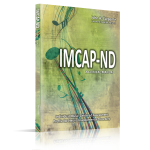For those who are interested, I’m providing the Introductory chapter from the IMCAP-ND in this blog post. Within the last week or so I’ve received many emails from music therapists asking questions pertaining to the manual, specifically about defining the three rating scales, as well as the “umbrella” of neurodevelopmental disorders. Thus, I”m including, below, the overview that describes the scales and the client groups within the “umbrella” of neurodevelopmental disorders. Thanks so much for all of your questions and please feel free to reach out if any others emerge!
OVERVIEW OF THE IMCAP-ND MANUAL
The Individual Music-Centered Assessment Profile for Neurodevelopmental Disorders (IMCAP-ND) is a criterion-referenced assessment of musical interaction, communication, cognition and perception, and responsiveness in musical-play for individuals with neurodevelopmental disorders. The IMCAP-ND can be used to evaluate clients at various developmental levels and chronological ages from children to adults.
Administering the IMCAP-ND requires the therapist to improvise music experiences based on the client’s interests and musical lead, while targeting specific musical responses that are relevant to neurodevelopmental disorders. The IMCAP-ND examines musical-emotional abilities, musical cognition and perception skills, as well as musical responsiveness that deals with preferences, perceptual efficiency, and self-regulation in musical-play.
Overview of the Chapters
The IMCAP-ND manual was designed to provide music therapists with a method to assess and evaluate a client’s musical resources, strengths, challenges, and overall responsiveness (i.e., preference, efficiency, and self-regulation) in musical-play. The IMCAP-ND manual includes three interrelated rating scales, definitions and criteria of target responses, assessment protocols, musical-clinical and interpersonal procedures, instructions for clinical observation and listening, procedures for supportive interventions, clinical considerations, and descriptions and rationale for clinical strategies and techniques.
Chapter 1
Chapter 1 provides the therapist with an introduction to the IMCAP-ND including its purpose and function, the data collection process, therapist’s qualifications, as well as a summary of neurodevelopmental disorders.
Chapter 2
Chapter 2 details the session format, description of media used in session, definition of musical-play and clinical improvisation, and presents clinical techniques that are specific to the
IMCAP-ND. In addition, the chapter discusses procedural considerations, three working phases within the process of musical interaction, range and intentionality in musical-play, and evaluating quality in musical-play interactions. Furthermore, the chapter offers procedures for dealing with perseverative behaviors in musical-play and outlines protocols and criteria for implementing supportive interventions.
Chapters 3, 4, and 5
Chapters 3, 4, and 5 provide detailed descriptions of the three rating scales that make up the IMCAP-ND—Scale I: Musical Emotional Assessment Rating Scale (MEARS),Scale II: Musical Cognitive/Perception Scale (MCPS), and Scale III: Musical Responsiveness Scale (MRS). The three scales, collectively, are designed to evaluate and identify the client’s musical resources, challenges, strengths, preferences, and overall responsiveness. Scale II (MCPS) (Chapter 4) and Scale III (MRS) (Chapter 5) provide the therapist with the client’s musical cognitive and perception abilities, preferences, and tendencies in musical-play, while Scale I (MEARS) examines the client’s social-emotional capacities in musical-play, i.e., attending, responding affectively, adapting, engaging, and interrelating.
Scale I: Musical Emotional Assessment Rating Scale
The Musical Emotional Assessment Rating Scale (MEARS) described in Chapter 3 is a criterion-referenced rating scale designed to examine the client’s musical ability to attend, respond affectively, adapt/engage in parallel play, engage/participate in parallel-interactive play, and interrelate/engage in true interactive play. The MEARS is based on five specific music domain areas: 1) musical attention, 2) musical-affect, 3) adaptation to music-play, 4) musical engagement, and 5) musical interrelatedness. Scoring the MEARS is based on the frequency of target response, level of support provided for the target response, as well as indicating the media in which the client offered the response. Chapter 3 discusses the scale in detail, including the sequence and criteria of each music domain area, clinical protocols and procedures, techniques, considerations, and scoring protocols.
Scale II: Musical Cognitive/Perception Scale
Chapter 4 presents the Musical Cognitive/Perception Scale (MCPS), a criterion- referenced scale designed to examine the client’s ability to react, focus, recall, follow, and initiate five musical elements, i.e., rhythm, melody, dynamic, phrase, and, timbre. Scoring the MCPS is based on the frequency of the target response as well as indicating the media in which the client offered the response. Chapter 4 discusses the framework of the MCPS and defines each construct of the scale. Chapter 4 also provides detailed descriptions of the clinical protocols, definitions and criteria for each target response, procedures, techniques, considerations, and scoring protocols.
Scale III: Musical Responsiveness Scale
The Musical Responsiveness Scale (MRS), introduced in chapter 5, is a criterion-based rating scale designed to evaluate the client’s overall responsiveness and tendencies in musical-play. Hence, the MRS deals with examining the client’s musical preferences, perceptual efficiency, and ability to self-regulate in musical-play. Scoring is based on the frequency of the target response in each media, i.e., vocal, instrumental, and movement. In addition, the chapter also discusses and defines each construct of the scale, provides criteria for each target response, clinical procedures, techniques, considerations, and scoring protocols.
Population-Based
The IMCAP-ND is a population-specific assessment tool developed for working with children, adolescents, and adults with neurodevelopmental disorders to address core features of the disorder. The IMCAP-ND is designed to target and assess key aspects and features of neurodevelopmental disorders such as relating, communicating, emotionality, language, cognitive functioning, and sensory-motor processing.
Neurodevelopmental disorders include pervasive developmental disorders (PDD) also referred to as autism spectrum disorders; speech and language disorders and attention deficit- hyperactivity disorder (ADHD) (Tager-Flusberg & Helen, 1999). In addition, neurodevelopmental disorders include genetic disorders, such as fragile-X syndrome, Down’s syndrome, Williams syndrome, Rett syndrome, and Angelman syndrome (ICDL, 2005; Tager-Flusberg & Helen, 1999; APA, 2000).
Core features of neurodevelopmental disorders generally impact communication, the ability to experience emotion (affect), language, cognitive functioning, sensory and motor processing, and in some cases impact relatedness (Zero to Three, 1994, 2005; Greenspan, 1992; ICDL, 2005; Tager-Flusberg & Helen, 1999).
Copyright © 2013 by John A. Carpente. Not to be reproduced in whole or part without written permission of the author. All rights reserved.
For more information or to purchase click IMCAP-ND: A Clinical Manual


I work with a very challenging TBI case- would this be the appropriate assessment tool for such a client?
Dear Melinda,
That’s a tough question, not knowing your clinical orientation/framework, or how you set up clincial goals and objectives. Therefore, i can only speak in general within the context of the IMCAP-ND. The scales are set up to examine the quality of musical interaction within the context of relating and communicating. Scales 2 and 3 attempt decifer the client’s musical-differences. These are the musical challenegs (e.g., difficulty engaging thriugh a range of tempo, or dynamic; challenegs in modualting from 1 musical context to another, or initatng ideas/communication in musicaly-play and so forth) that get in the way of the client’s ability to engage in higher levels of musical interaction. In additon, scales 2 and 3 inform the therapist’s music in order for him/her to provide musical experiences that support the Clint’s differences. Furthermore, scale 1 examines the client’s musical-social ability in musical-play with the therapist. Thus, the therapist provides the client support based on scales 2 and 3 in order to help them move up the ladder of scale 3. All of that being said, musical-clinical procedures are provided in and through clinical improvisation. Thus, target musical responses are examined in musical-play, within the context of social-emotional skills. Hence, IMCAP views music therapy within a social orientation and focuses on understanding the client’s ability to relate, communicate, and think in musical-play.
I hope this helps and thanks for your interest in the IMCAP-ND.
All the best,
John
the TBI client is through a local school district so I have to use IEP Direct and behavioral measuring goals…education goals. Her responses are quite inconsistent and often quite subtle…
At the Rebecca Ctr for Music Therapy (where I work), we exclusively use IMCAP-ND goals and protocols in our clinical work and have been successful getting MT on the IEPs as well as utilizing IMCAP-based goals to justify IEP goals. What our staff has done during CSE/IEP meetings is to discuss IMCAP goals within the context of being pre-requisites for learning (some of the social IEP goals do coincide with IMCAP’s). In addition, we have noticed that the IMCAP-ND has been a great tool to frame the clinical MT work to districts (and other healthcare professionals) in regards to explaining process, progress, and rationale for musical-clinical interventions. All of that being said, I want to make clear that I am not saying that my experiences with districts and IEPs will be the same as others. I’m just sharing how it’s played out at my Center.
best,
John
thank-you John!